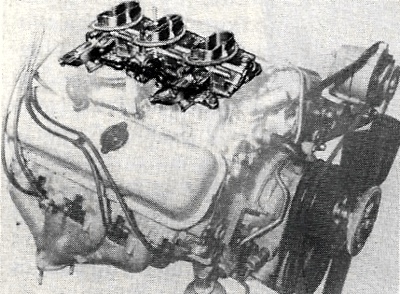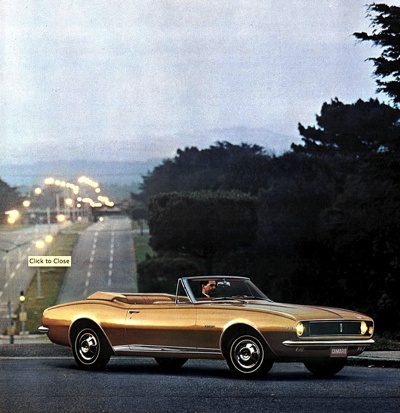|
American Muscle Cars of 1967
|
Country: |
 |
|
Birth of the Camaro
In
1967 Detroit was dishing out plenty of performance. Sophistication came to the ranks of muscle-cars, as companies honed their products to a fine edge. The nitty-gritty of styling and image gimmicks were pursued, while some cost-cutting tricks were explored. The year witnessed the birth of the Camaro and the arrival of the Firebird, GM's long-awaited answers to the ultra-successful Mustang. On a 108-inch wheelbase, they had the popular long-hood, short-deck ponycar styling, with a setback
engine location that gave good traction and handling. Mopar "letter cars" hit the streets too.
Though Chrysler was the last of the Big Three to get its "GTO"-type cars into the showrooms, it wasn't because the company was slower to see the market trend or tool up. The Mopar sales people were simply willing to lose a year to get a better feel for what this new street market really wanted. And the wait paid off. Chrysler really turned the tables on the GM and Ford forces.
The new
1967 Dodge R/T and Plymouth had the usual intermediate-sized body as the others did. But instead of holding
engine size to around 400 cubic inches as CM and Ford did, Chrysler dropped in its 440-cube "Magnum" high block, with special big-port heads, strong hydraulic cam, beefed-up bottom end and split-flow
exhaust manifolds.
With 30 to 40 more net hp than the GM and Ford standard musclecar engines, the Mopars could turn quarters in the mid-14s at 95 to 98 mph, bone stock. The competition couldn't touch them. It was a real coup for Chrysler, especially when a buyer could order the wild Street
Hemi package for an extra $750 or so. Mopar fanatics were well taken care of in
1967. The Chevrolet executives were happy too, knowing the
1967 Camaro was a success. But earlier in the season, they realised that the 350-cubic-inch, 295-hp motor would be no match for the new 390 Mustang. Good thing they had a 396 on the shelf, good for all the way up to 375 hp.
It was obvious GM was declaring all-out war in the ponycar market. A look at the freshly introduced Firebird would underscore that m statement. Borrowing GTO's 400-cubic-inch mill, the Firebird's big-| gest
engine option was rated at 325 hp, whether or not it came equipped with the Ram Air package. Identical engines in the GTO ^^ were rated higher because GM had an iron-clad internal policy that limited all its divisions to a maximum of 1 hp per 10 pounds of vehicle weight. With the Firebird on the scales at 3250 pounds, engines would have a ceiling of 325 hp. There was even a power-limiting tab on the Quadrajet's secondary throttle linkage to meet this edict, which you could bend out of the way to pick up an instant 25 hp.
Year of the Goat

The new 427/435 Corvette engine brought Chevrolet back to tri-carbs.
 1966 Camaro.
1966 Camaro.
 Chrysler's 440 cube Magnum engine found its way into the Mopar intermediate body line.
Chrysler's 440 cube Magnum engine found its way into the Mopar intermediate body line.
|
Another anti-performance GM policy was a ban on multiple carburettor systems on passenger cars. This meant that the Tri-Power GTOs and tri-carb Olds 4-4-2s became history overnight. That made GM service people happy, because the complex throttle linkages had been the source of many warranty headaches. It was ironic that in the 12-year cycle of the Vietnamese calendar,
1967, the year the GTO lost its multiple carbs, was the Year of the Goat.
But the GTO didn't lose its sales appeal, as the 389 was increased to 400 cubic inches. Split-flow
exhaust manifolds and Ram Air were great options to have under the hood. The Corvette, because it was classified a sports car, escaped the tri-carb ruling and incorporated a new three carburettor setup for the L71 427, rated at 435 hp. The vacuum diaphragm system never worked as well as the single-quad L72 of the prior year, though for pure street muscle not much could touch that beautiful big-block. Chevy also produced 20 L88-powered cars, for competition use only — awesome then as a powerhouse, awesome today as a collectible.
A less obvious but very important performance breakthrough in the GM camp was the new Turbo Hydramatic 400 3-speed automatic. Prior to this, big-horsepower GM variants were limited to 4-speeds or wimpy
2-speed Powerglides. Americans were just beginning to learn what the
automobile was doing to their environment. Pollution controls were becoming far more evident, though in 196 7 it was just the tip of the iceberg. The California Air Resources Board (CARB) was the strictest in the nation when it came to smog devices, much as it is today. Full-sized Chevrolets were re-skinned completely and could still be had with the Impala SS package and 425-hp 427s.
The real butt-kickers were the lighter Biscaynes with that
engine combination. Chevelles remained basically as they were in 1966. Chevy managed to scoop Ford on one thing, the Z/28. Originally planned for limited production just to make the body and 302-cube
engine available for SCCA Trans-Am racing, the car was an instant hit.
Because the rules required a production power-plant of 305 cubic inches or less, the late Vince Piggins pulled an old hot rodder stunt. The 283 was too small and the 327 too big. But when a 283 crank went into a 327 block, Chevy wound up with the legendary 302. Too bad Chevy could build only 602 units after a late start. This was a musclecar innovation capable of high 14-second quarters at 95 to 98 mph. And what a handler!
The Buick Gran Sport 400
Over at Buick, the big news was that the 15-year-old Nail Valve V8 was finally replaced with a brand-new, modern big-block with lighter weight, better breathing and higher rev potential. The Gran Sport 400 was competitive on the street at last. Jayne Mansfield should have -stayed away from Buicks. She died in a horrifying wreck in Louisiana, when the Buick she was riding in plowed into a truck on a lonely stretch of highway.
As the race to the moon progressed, the U.S. was dealt a severe setback when astronauts Virgil Grissom,_ Edward White and Roger Chaffee perished in a launch pad fire aboard Apollo I. The country was still in shock as NASA dug in with both heels, refusing to lose momentum in its shot at the moon.
In US motorsport
Mario Andretti won the Daytona 500 in a 427 Ford Fairlane with the new "tunnel port"
cylinder heads, while A.J. Foyt won his third Indy 500 in a Ford-powered Coyote. Foyt also shared the driving chores with Dan Gurney, as they piloted a Ford GT-40 to victory in the Le Mans 24-hour race. The World Driving Championship , better known as Formula One, was taken by New Zealander Denis Hulme. Richard Petty was NASCAR's champ, driving a Plymouth.
The very successful Mustang received its first major redesign, bigger and heavier of course, but wider as well. This allowed room for a big-block, namely the mild 390 "GT"
engine rated at 335 hp. The Mustang had at last achieved true musclecar status.Another important development at Ford in
1967 was that the 427 8-barrel
engine became a regular production option in the mid-sized Fairlane and Mercury Comet. With a neat hood scoop and cold air system, it made for an awesome street competitor. The engines were available in a variety of combinations with different outputs.



